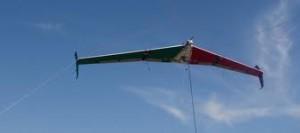 Recently I was reading about Google X, which is Google’s “phantom works” and the article mentioned that in addition to some high profile inventions such as driverless cars and Google glass, the company had recently bought Makani Power, an airborne wind energy company. This peaked my interest as to what exactly is airborne wind energy.
Recently I was reading about Google X, which is Google’s “phantom works” and the article mentioned that in addition to some high profile inventions such as driverless cars and Google glass, the company had recently bought Makani Power, an airborne wind energy company. This peaked my interest as to what exactly is airborne wind energy.
Simply put airborne wind energy can be several different things. It can be a really big kite, flown very high that generates energy or a wind turbine kept afloat by a kite-like device tethered to the ground.
The kites can be up to 25 square meters which will produce enough electricity to supply 40 households. The method of creating electricity from kites varies between companies but one of the more popular options is to use the pulling power of the kite to unwind a cable which then drives a ground-based generator as the kite pulls the cable higher and higher. The problem then is how to retrieve the cable expending as little energy as possible. This is accomplished by flying the kite into the wind thus letting the air currents provide some of the energy needed to reel in the kite.
The kites fly at a height of between 100-300 meters but can be flown much higher. For reference the average wind turbine is 200 meters tall. As the wind currents are more stable the higher above the earth you go so deploying the kites at greater heights allows for a fairly constant air flow as compared to wind turbines which must deal with a more unpredictable air flow and must have sophisticated software to deal with surges and drops in wind speed.
The airborne wind turbine, which is the product that Makani Power makes, consists of an wind turbine, held aloft on a tether that generates electricity which is brought back down to earth through the tether.
The biggest disadvantage to kite power seems to be that it is a technology in the development phase and must rely on investors taking a risk on a relatively unproven product. Of course all new technologies must go through this phase. The fact the Google X bought Makani Power is an indication that, at least, Google thinks that this technology has a promising future which is promising.




